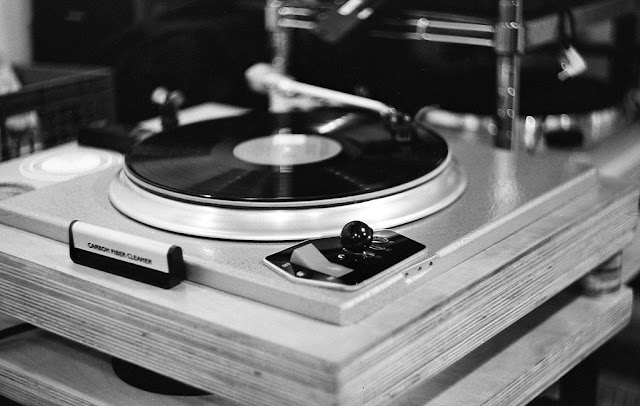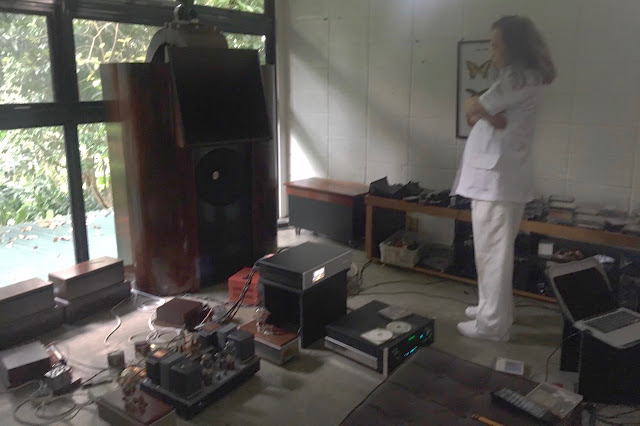Magnavox CDB465
The Magnavox CDB465 was the no-frills entry level model marketed ca. 1987. Its more upmarket contemporaries were the CDB460, CDB560 and
CDB650. Since it shares the same DAC and audio section as its more expensive siblings, they are sonically on equal footing.
I wanted all my modifications to be reversible so I installed IC sockets for the audio op-amps and
SAA7220 digital OverSampling filter. The original electrolytic output caps were replaced with 4.7uf WIMA polyester caps.
Since there were no "bulging" electrolytic power supply capacitors and the AC line current draw monitored on my Variac was very normal, I didn't deem it necessary to recap the entire unit.
 |
Typical dual op-amps found in
80s vintage Philips/Magnavox CD players:
NE5532N and LM833N
+
the FET-input OPA2604AP |
This modification follows the footsteps of
Walt Jung's article on page 74 of the June 1987 issue of Audio. Walt discussed the importance of op-amps with fast slew rate and higher quality output capacitors for better audio performance. Although the
Burr-Brown OPA2604APs I chose date from the late 90s, they are still sonically respected due to their FET-inputs, which supposedly give them a "tubey" quality.
There's a plethora of cheap Burr-Brown op-amps from Chinese sellers, but I didn't want to risk getting fakes. So I searched hard and found some for less than $5 each from a seller in Texas.
The polyester caps + OPA2604AP op-amps cleaned up the sound. I heard less digital screech at the top end and an overall improvement in definition across the audio band.
I don't consider cutting traces in the PC board and using jumper wires
à la Lampizator as reversible. So I ordered this plug 'n play
NVKaudio NOS/re-clock module for $30/shipped from Bulgaria. I was quite taken aback by the improvement in sound when I installed this NonOverSampling module in place of the SAA7220 digital OS filter. The high frequencies opened up, the midrange became more luminous, detail and definition improved without additional harshness and it had better dynamic contrasts. It was an experience reminiscent of the first time I fired up my DIY
no-negative feedback PP2A3 amp in the early 90s.
To objectify these two modifications, the op-amp/output cap upgrade gave at least a 10% improvement, while the shift to NOS = 40%! If this NOS modification was known in the 80s, I probably would've been more amenable to CD technology then. Oh well, as they say, better late than never. 😊
My problem now is, I want a stand-alone TDA1541-based DAC to connect to my
Pi 3B+/Allo DigiOne or any digital transport. Can it be done on a modest budget?
TDA1541 Chinese DAC Kit
This fully assembled DAC board sans TDA1541 chip cost $50 shipped from China. For another $30 I got an R-core power transformer with dual 15V + dual 9V secondary + 120/240V primary windings. Within less than an hour, I had a TDA1541 DAC on a breadboard ready for listening.
It has 3 digital inputs including a
PCM2704-based USB interface + optical or coaxial feeding a CS8412 receiver. The audio section came with single
NE5534N op-amps (2 per channel) and polyester WIMA caps in the output section. Adjacent to the empty TDA1541 socket is a socketed SAA7220P/C digital oversampling filter. With seven heat-sinked regulators and a battery of filter capacitors, I surmise that every section of this DAC is independently filtered and regulated.

The topology reminded me of the innards of D/A sections of
upmarket CD players and DACs from the TDA1541 era. For example, the TDA1541 socket is surrounded by film-type capacitors, which is a recommended upgrade to the
SMDs found in mainstream mid-80s Philips/Magnavox CD players.
Using a TDA1541 chip I scavenged from a dead CDB2041, I fed this DAC with the output stream of the modified CDB465 above with its SAA7220 digital filter re-installed*. Honestly, I could not conclusively discern a difference between the output of this DAC and the modified audio section of the CDB465. This can only mean that this DAC must be doing something better...
*
NOTE: removing the SAA7220 digital filter disables the digital coaxial output of any Philips/Magnavox CD player from the TDA1541/1543 era
The stock
Adcom GDA600 offers better detail resolution and definition + a smidgen better extension in the frequency extremes compared to this TDA1541 DAC. But there is something organic about how the TDA1541 DAC presents music especially in the midrange, which makes it musically more satisfying.
After a couple of days, I upped the stakes and upgraded the
NE5534Ns op-amps to FET-input
OPA604s. Then I pulled out the SAA7220P/C digital filter and inserted a simpler NOS module I made from a 24-pin socket and three jumper wires (above, right) based on a tip from this DIYer's
website. Thanks, man!
Please note that my 24-pin socket/3-jumper wire NOS concoction
doesn't work with CD players, only with outboard DACs. The NVKaudio NOS module works with
both CD player and outboard DAC. The good news is, in a DAC application, I don't hear a sonic advantage using the NVKaudio NOS module over my cheap NOS concoction.

With the OPA604s installed and the SAA7220P/C chip replaced by my DIY NOS module, the TDA1541 Kit (fed by the digital stream of either a Magnavox CDB650 or a Sony CDP 505esD) overtook the modified CDB465 with the NVKaudio NOS module in terms of midrange warmth and definition across the audio band. The edge in detail retrieval that the
Adcom GDA600 had was narrowed, while the NOS TDA1541 DAC with op-amp upgrade pulled ahead in terms of midrange warmth and dynamics.
I didn't consider a further upgrade to
Burson or
Sparkos discrete op-amps because they are expensive and by nature, these devices rely on negative feedback (NFB) to achieve linearity. IME as a vacuum tube DIYer, NFB satisfies the scope and meters but not my ears. 😜
Arcam Delta Black Box
I lucked out on a Delta Black Box which needed some work. Fortunately, a
service manual is available online. After replacing a couple of fried resistors, music!
 |
Musical Fidelity Digilog
Courtesy of Google |
I also wanted to try a Digilog, but in hindsight, it was a good thing I couldn't afford those that came up for sale. Based on the picture above, it was a textbook, albeit deluxe, implementation of the TDA1541 DAC chip. Except for the digital input receiver section, the D/A circuit topology is very similar to the CDB465 and Chinese kit above - TDA1541 DAC output > op-amp ICs in the audio stage > coupling caps at the output to block DC offset.
I'm not sure if the TDA1541A S2 (dual crown) chip in the picture above was originally supplied with this unit, probably not. Stereophile's favorable review of the Digilog over the Arcam Delta Black Box is probably the reason why they command higher resale prices.
 |
| Arcam Delta Black Box |
In stark contrast, the Arcam Delta Black Box is actually the more sophisticated design. It used discrete components with Class A operating points, instead of audio op-amp ICs. The audio stage is a direct coupled design = no capacitors in the signal path. The op-amps visible are part of a DC servo circuit that controls DC offset at the output.
It did have a tendency to sound a bit hot on the top end. But I could hear its untapped potential, excellent bass definition and extension + a midrange that is still very TDA1541-like. Since there are no capacitors that I could "tune to taste" with paper in oils, I carefully unsoldered the SAA7220P/B digital OS filter and installed a 24-pin socket.
Running the Delta Black Box in NOS mode got rid of all the nastiness in the top end. The high frequencies opened up with shimmer and airiness, the midrange became more focused and bass response and extension is the best I've heard from CDs so far. It was clearly better than my mod'ed CDB465 above with NVKaudio NOS module, op-amp upgraded and NOS TDA1541 Chinese DAC kit and stock
Adcom GDA600. Although not quite as lucid in the midrange as the
Audio GD R2R-11, the frequency extremes were much better.
Now that I've heard a few TDA1541 DAC topologies and have compared them to a PCM-63 based DAC + a discrete R2R design, I'm quite confident that my ideal DAC would use an NOS TDA1541 DAC chip coupled to a tube output stage.
PS: I can't hear the difference between the TDA1541 and TDA1541A. I have no experience with the specially selected S1 or S2 samples. Does anyone care to send me a sample (or two) to try? 😉



























































